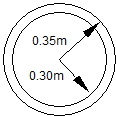The mass per unit length and the polar inertia per unit length are related terms. The mass per unit length is a measure of the inertia of the structure with respect to translation. The polar inertia is a measure of the inertia of the structure with respect to torsional rotations about the cross section axis.
The mass per unit length m is calculated as the product of the cross-sectional area A and the mass density (mass per unit volume) r of the material. Similarly the polar inertia per unit length p is the product of the polar moment J of the cross-section and the mass density r. The dimensions of p are [Mass][Length]. In the SI system of units, p is typically in kg.m. In Imperial units, p is typically in slugs.ft.
Note that the influence of the value of p on the solution in very many cases is small. Also, in a 2D analysis, the value of p (and indeed the value of GJ) is of course immaterial.
Consider a steel pipe as shown in the figure below. The density ![]() of the pipe material is 7850 kg/m3. The pipe inside and outside diameters are 0.30m and 0.35m respectively. The calculation of p is as follows:
of the pipe material is 7850 kg/m3. The pipe inside and outside diameters are 0.30m and 0.35m respectively. The calculation of p is as follows:

Example Polar Inertia Calculation
Polar moment, J, is given by:

= 6.78´10-4 m4
Polar moment of inertia per unit length, p = J.![]()
= (6.78´10-4).(7850) kg.m
= 5.32 kg.m